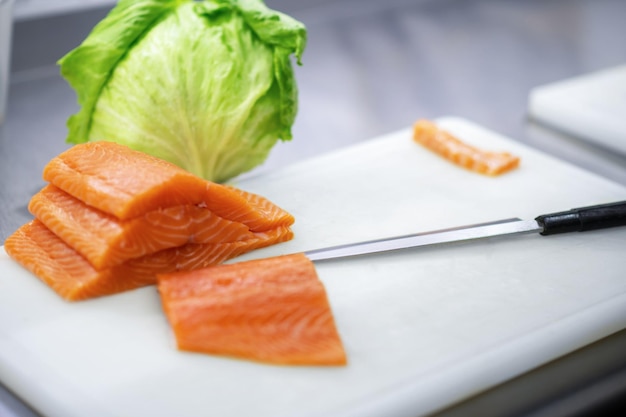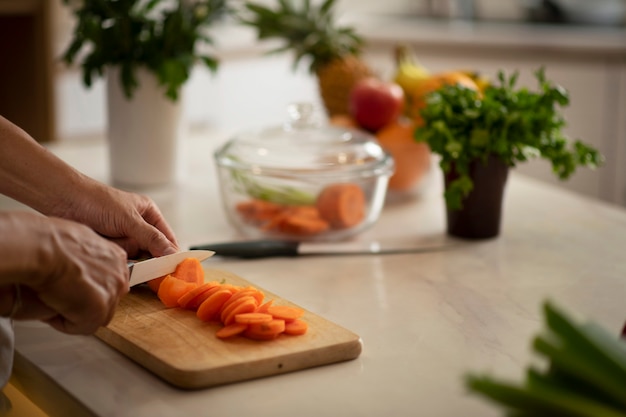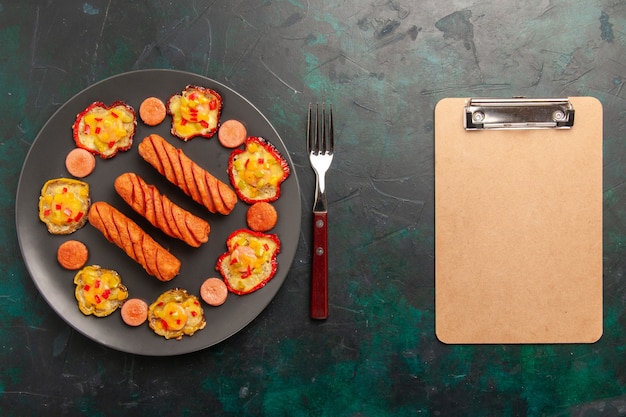Salmon. Just the name conjures images of glistening pink fillets, smoky grilled aromas, and a succulent, flaky texture that melts in your mouth. As a seasoned cook, I can confidently say that salmon is a culinary champion, versatile enough for any occasion and delicious prepared in countless ways. But let's be honest, there's one crucial element that can make or break a salmon dish – the cooking temperature.
Get it wrong, and you're left with dry, overcooked fish. Get it right, and you're rewarded with juicy, flaky perfection. Over the years, I've had my fair share of salmon mishaps (we've all been there!), but I've also learned a thing or two about achieving that perfect internal temperature. Today, I want to share those secrets with you, demystifying the science and guiding you towards salmon-cooking mastery.
(Part 1) Understanding the Science of salmon cooking

Before we dive into the specifics of temperature, let's unpack the science behind salmon cooking. The secret lies in protein denaturation. When you heat salmon, the proteins within its structure begin to unravel and reorganize, resulting in the delicious flaky texture we all crave. This is a good thing! But overcook it, and those proteins become tough and rubbery, ruining the whole experience.
The key to success is stopping the cooking process at the exact moment when the proteins have denatured enough for tenderness, but haven't gone too far. This sweet spot, the ideal internal temperature, varies depending on the thickness of the salmon and the cooking method.
Measuring the Temperature: Your Culinary BFF
The most reliable way to ensure perfectly cooked salmon is to use a trusty digital instant-read thermometer. These handy gadgets are inexpensive, easy to use, and take the guesswork out of cooking. Simply insert the probe into the thickest part of the salmon, making sure it doesn't touch any bones, and check the temperature.
Don't rely solely on visual cues like colour – they can be misleading, especially with skin-on salmon. Trust the thermometer. It's your culinary BFF, always there to provide accurate guidance.
(Part 2) The Golden Rule: Aim for 145°F (63°C)

Here's the golden rule for salmon cooking: the internal temperature should reach 145°F (63°C) for the safest and most delicious results. This is the temperature at which the salmon is cooked through, ensuring any potential bacteria is eliminated.
However, there's a slight catch. That temperature applies to the center of the salmon. If the fillet is thick, the outer edges may already have reached 145°F (63°C) while the center is still undercooked. This is where understanding salmon thickness becomes crucial.
(Part 3) Thickness Matters: A Guide to cooking times

The thickness of your salmon dictates how long it takes to reach that desired internal temperature. Here's a general guide for salmon thickness and cooking times, assuming a standard oven temperature of 350°F (175°C) and a pan-frying temperature of medium-high heat:
Remember, these are just guidelines. You may need to adjust cooking times based on your specific salmon thickness, the method you choose, and the heat of your oven or stovetop. Always check the internal temperature with your trusty thermometer to ensure it reaches 145°F (63°C).
Thickness and Cooking Time
| Salmon Thickness (inches) | oven cooking time (minutes) | Pan-Frying Time (minutes) |
|---|---|---|
| 1/2 inch | 8-10 | 3-4 |
| 1 inch | 12-15 | 5-6 |
| 1 1/2 inches | 18-20 | 8-10 |
| 2 inches | 25-30 | 12-15 |
(Part 4) The Art of Resting: Allowing the Juices to Redistribute
Resting is a crucial step that's often overlooked, but it makes a world of difference in the final outcome. Allowing the salmon to rest for a few minutes after cooking gives the juices a chance to redistribute throughout the fish, resulting in a more tender, flavorful experience.
Cover the salmon loosely with foil to keep it warm and moist, and let it rest for about 5-10 minutes before serving.
(Part 5) Don't Overcook It! Signs of Perfectly Cooked Salmon
overcooked salmon is a culinary tragedy. It loses its moisture and becomes dry and flaky, with a texture that's closer to cardboard than the delicious, melt-in-your-mouth experience we're aiming for.
To avoid this, check the internal temperature regularly and stop cooking as soon as it reaches 145°F (63°C). Don't be afraid to err on the side of undercooked – the salmon will continue to cook slightly as it rests after being removed from the heat.
Here's how to tell if your salmon is cooked to perfection:
- Internal temperature: The internal temperature should reach 145°F (63°C) in the thickest part of the salmon, as measured with a thermometer.
- Texture: The salmon should be flaky and tender, offering a gentle resistance when pressed with a fork. The flakes should easily separate, indicating it's cooked through.
- Color: The color of the salmon will transform as it cooks. It will transition from a translucent pink to a more opaque, slightly lighter pink.
(Part 6) The "Flaky" Factor: A Sign of Success
One of the most satisfying elements of perfectly cooked salmon is its flaky texture. It should break into easy, delicate flakes when you gently press it with a fork. If the salmon is tough and rubbery, it's likely been overcooked.
(Part 7) Different Cooking Methods, Different Approaches
While the internal temperature of 145°F (63°C) is a universal guideline, the cooking time and method can affect how the salmon cooks. Here's a breakdown of some common cooking methods and their corresponding cooking times:
Oven Baking: Even Cooking for Delicious Results
Baking is an excellent way to cook salmon evenly. Place the salmon on a baking sheet lined with parchment paper and bake at 350°F (175°C) for 12-15 minutes for a 1-inch thick fillet.
Pan-Frying: Quick and Easy for weeknight dinners
Pan-frying is a quick and easy way to cook salmon for a weeknight dinner. Heat a pan over medium-high heat and add a little oil. Place the salmon skin-side down in the pan and cook for 4-5 minutes per side.
Grilling: Adding Smoky Flavor to Your Meal
Grilling is a great way to add smoky flavor to your salmon. Preheat the grill to medium-high heat. Place the salmon on the grill and cook for 4-5 minutes per side, ensuring the grates are clean to prevent sticking.
smoked salmon: A Delicate Treat
Smoked salmon is a delectable and versatile option. While it's typically already cooked, it's important to check the internal temperature to ensure it's reached 145°F (63°C) if you're unsure about its origins.
(Part 8) Playing with Flavors: Embracing the Versatility of Salmon
Now that you've mastered the perfect salmon cooking temperature, it's time to embrace the joy of flavor! Salmon pairs beautifully with a wide array of ingredients. Here are a few ideas to spark your creativity:
- Citrus: Lemon, lime, and orange zest and juice add a bright, refreshing element to salmon.
- Herbs: Dill, parsley, chives, and tarragon all elevate the flavor of salmon.
- Spices: A pinch of paprika, cayenne pepper, or smoked paprika adds a touch of heat and depth.
- Vegetables: Roasted vegetables like asparagus, broccoli, and zucchini complement salmon perfectly.
- Sauces: Salmon pairs well with creamy sauces like béarnaise or hollandaise, or lighter sauces like a lemon-dill sauce.
(Part 9) FAQs: Answering Your Burning Questions
Here are some frequently asked questions about salmon cooking temperature:
What happens if I overcook salmon?
Overcooked salmon becomes dry and tough, losing its delicate, flaky texture. The color will also become more opaque and pale, signaling that it's been cooked too long.
Can I cook salmon to a lower temperature?
While 145°F (63°C) is the recommended internal temperature, some prefer a lower temperature, around 140°F (60°C). This results in a more moist and tender fish. However, it's important to note that this may not be as safe as cooking to 145°F (63°C).
How do I know if salmon is cooked through without a thermometer?
A thermometer is the most reliable way to determine doneness. However, you can also look for visual cues. The salmon should turn from translucent to opaque, and the flesh should easily flake when pressed with a fork. These cues are less reliable than using a thermometer.
What should I do with leftover salmon?
Leftover salmon can be enjoyed cold or warmed up. It's fantastic in salads, sandwiches, or even added to pasta dishes. Store it in the refrigerator for up to 3 days.
Is it okay to eat raw salmon?
It's not recommended to eat raw salmon, as it can contain parasites that can cause illness. However, sushi-grade salmon is safe to eat raw, as it has been carefully inspected and frozen to kill any parasites. Always purchase from reputable sources.
cooking salmon to the perfect temperature takes a little practice, but it's definitely worth the effort. Remember, always check the internal temperature with a thermometer to ensure it's cooked through, and don't be afraid to experiment with different flavors and cooking methods. With a little practice, you'll be a salmon-cooking superstar!
Everyone is watching

Corn on the Cob: The Ultimate Guide to Perfectly Cooked Ears
Healthy MealsAh, corn on the cob. Just the name evokes images of sunny days, barbecues, and that sweet, juicy flavour that ...

Perfect Pork Roast Oven Cooking Time: A Guide to Delicious Results
Healthy MealsThere's something truly satisfying about a perfectly roasted pork. The aroma alone is enough to make your mout...

Ham Cooking Time: How Long to Bake, Smoke, or Boil a Delicious Ham
Healthy MealsAh, ham. It's a classic, isn't it? A real crowd-pleaser, especially around holidays. And when done right, it'...

Scallops: The Ultimate Guide to Perfect Cooking
Healthy MealsAh, scallops. Those delicate, sweet, and utterly delicious morsels of the sea. They hold a special place in my...

Spaghetti Squash: The Ultimate Guide to Cooking and Serving
Healthy MealsRemember that time you saw spaghetti squash at the supermarket, looking all bumpy and strange, and thought, "W...
